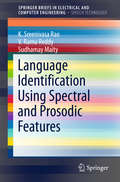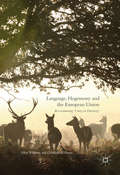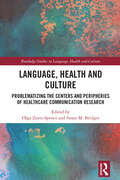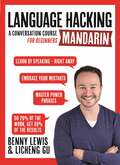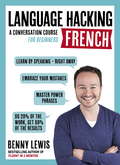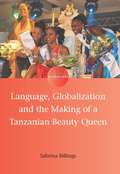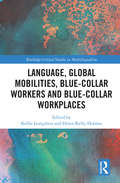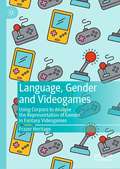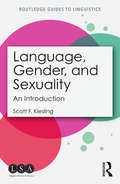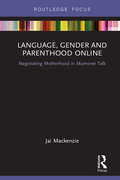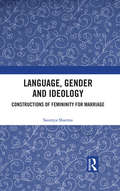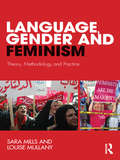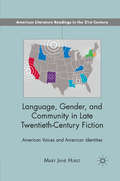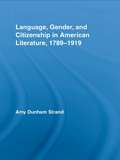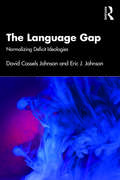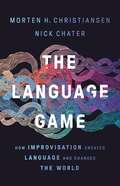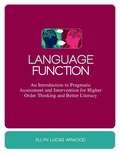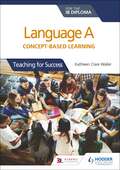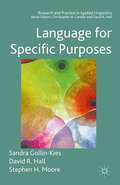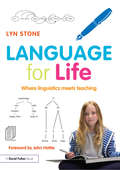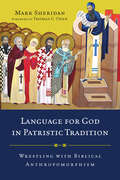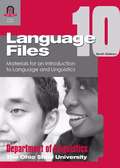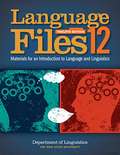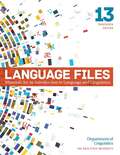- Table View
- List View
Language Identification Using Spectral and Prosodic Features
by K. Sreenivasa Rao V. Ramu Reddy Sudhamay MaityThis book discusses the impact of spectral features extracted from frame level, glottal closure regions, and pitch-synchronous analysis on the performance of language identification systems. In addition to spectral features, the authors explore prosodic features such as intonation, rhythm, and stress features for discriminating the languages. They present how the proposed spectral and prosodic features capture the language specific information from two complementary aspects, showing how the development of language identification (LID) system using the combination of spectral and prosodic features will enhance the accuracy of identification as well as improve the robustness of the system. This book provides the methods to extract the spectral and prosodic features at various levels, and also suggests the appropriate models for developing robust LID systems according to specific spectral and prosodic features. Finally, the book discuss about various combinations of spectral and prosodic features, and the desired models to enhance the performance of LID systems.
Language, Hegemony and the European Union
by Glyn Williams Gruffudd WilliamsThis book critically examines the European Union's "Unity in Diversity" mantra with regard to language. It uses a theoretical framework based on hegemony both as a system and as a relationship. Operating within sociolinguistics, the book replaces the notion of ideology in poststructuralist thought with that of hegemony. The authors argue that forging unity across language communities contradicts the tenets of classical liberal theory. Global neo-liberalism influences this orthodoxy, shifting the parameters of power and political control. Over nine chapters, the authors cover topics such as globalization and social change, justice, governance and education. The book will be of interest to sociolinguists, political scientists, sociologists, as well as scholars of language and globalization and European studies.
Language, Health and Culture: Problematizing the Centers and Peripheries of Healthcare Communication Research (Routledge Studies in Language, Health and Culture)
by Olga Zayts-Spence Susan M. BridgesLanguage, Health and Culture brings together contributions by linguistic scholars working in the area of health communication in Asia—in particular, in Hong Kong, Mainland China, Singapore, Japan and Taiwan. Olga Zayts-Spence and Susan M. Bridges, along with the contributors, draw on a diverse range of authentic data from different (primary, secondary, digital) healthcare contexts across Asia. The contributions probe empirical analyses and meta-reflections on the empirical, epistemological and theoretical foundations of doing research on language and health communication in Asia. While many of the medical and technological advances originate from the ‘non-English-dominant’/‘peripheral’ contexts, when it comes to health communication, there is a strong tendency to downplay and marginalize the scope and the impact of the ripe research tradition in these contexts. The contributions to the edited volume problematize the hegemony of dominant (Anglocentric) traditions in health communication research by highlighting culture- and context-specific ways of interpreting different health realities through linguistic lenses.
LANGUAGE HACKING MANDARIN (Learn How to Speak Mandarin - Right Away): A Conversation Course for Beginners
by Benny LewisCrack the Code and Get Fluent Faster!"I had to learn [a new language] in a handful of days for a TV interview. I asked Benny for help and his advice was invaluable." - Tim Ferriss What if you could skip the years of study and jump right to speaking Mandarin? Sound Crazy? No, it's language hacking. It's about learning what's indispensable, skipping what's not - and using what you've learned to have real conversations in Mandarin - from day one!Unlike most traditional language courses that try to teach you the rules of a language, Language Hacking Mandarin, shows you how to learn and speak Mandarin immediately through proven memory techniques, unconventional shortcuts and conversation strategies perfect by one of the world's greatest language learners, Benny Lewis, aka the Irish Polyglot. The Method Language Hacking takes a modern approach to language learning, blending the power of online social collaboration and the 80/20 principle of learning (Benny's ten #languagehacks show you how to achieve more with less!). It focuses on the conversations and language that learners need to master right away, rather than presenting language in the order of difficulty like most courses. This means you can start having conversations immediately. Course FeaturesEach of the 10 units culminates with a speaking mission that you can choose to share on the italki Language Hacking learner community (www.italki.com/languagehacking) where you can give and get feedback and extend your learning beyond the pages of the book. The audio for this course is available for free on library.teachyourself.com or from the Teach Yourself Library app.You don't need to go abroad to learn a language any more.
LANGUAGE HACKING FRENCH (Learn How to Speak French - Right Away): A Conversation Course for Beginners
by Benny LewisCrack the Code and Get Fluent Faster!"I had to learn [a new language] in a handful of days for a TV interview. I asked Benny for help and his advice was invaluable." - Tim Ferriss What if you could skip the years of study and jump right to speaking French? Sound crazy? No, it's language hacking. It's about learning what's indispensable, skipping what's not - and using what you've learned to have real conversations in French - from day one!Unlike most traditional language courses that try to teach you the rules of a language, Language Hacking French shows you how to learn and speak French immediately through proven memory techniques, unconventional shortcuts and conversation strategies perfect by one of the world's greatest language learners, Benny Lewis, aka the Irish Polyglot. The Method Language Hacking takes a modern approach to language learning, blending the power of online social collaboration and the 80/20 principle of learning (Benny's ten #languagehacks show you how to achieve more with less!). It focuses on the conversations and language that learners need to master right away, rather than presenting language in the order of difficulty like most courses. This means you can start having conversations immediately. Course FeaturesEach of the 10 units culminates with a speaking mission that you can choose to share on the italki Language Hacking learner community (www.italki.com/languagehacking) where you can give and get feedback and extend your learning beyond the pages of the book. The audio for this course is available for free on library.teachyourself.com or from the Teach Yourself Library app.You don't need to go abroad to learn a language any more.
Language, Globalization and the Making of a Tanzanian Beauty Queen
by Sabrina BillingsThrough micro-analysis of language use, this book chronicles young women's pathways to becoming a Tanzanian beauty queen, offering an original perspective on the intersection of language with globalization, nationalism, and inequality in urban East Africa. This compelling linguistic ethnography considers the real-life effects, both on- and off-stage, of language policy, education, and gender dynamics for the women competing in the pageants. While highlighting many contestants' struggles for escape from poverty and patriarchy, the book also emphasizes their creative strategies - linguistic and otherwise - for bettering their lives and shows how people living in a global economic periphery take part in, and sometimes feel left out of, the wider world.
Language, Global Mobilities, Blue-Collar Workers and Blue-collar Workplaces (Routledge Critical Studies in Multilingualism)
by Kellie Gonçalves Helen Kelly-HolmesThis collection brings together global perspectives which critically examine the ways in which language as a resource is used and managed in myriad ways in various blue-collar workplace settings in today’s globalized economy. In focusing on blue-collar work environments, the book sheds further light on the informal processes through which top down language policies take place in different multilingual settings and the resultant asymmetrical power relations which emerge among employees and employers in such settings. Taking into account the latest debates on poststructuralist theories of language, the volume also extends its conceptualization of language to demonstrate the ways in which it extends to a wider range of multilingual and multimodal resources and communicative practices, all of which combine in unique and different ways toward constructing meaning in the workplace. The volume’s unique focus on such workplaces also showcases domains of work which have generally until now been less visible within existing research on language in the workplace and the subsequent methodological challenges that arise from studying them. Integrating a range of theoretical and methodological approaches, along with empirical data from a diverse range of blue-collar workplaces, this book will be of particular interest to students and researchers in critical sociolinguistics, applied linguistics, sociology, and linguistic anthropology.
Language, Gender and Videogames: Using Corpora to Analyse the Representation of Gender in Fantasy Videogames
by Frazer HeritageThis book explores how corpus linguistic techniques can be applied to close analysis of videogames as a text, particularly examining how language is used to construct representations of gender in fantasy videogames. The author demonstrates a wide array of techniques which can be used to both build corpora of videogames and to analyse them, revealing broad patterns of representation within the genre, while also zooming in to focus on diachronic changes in the representation of gender within a best-selling videogame series and a Massively Multiplayer Online Role Playing Game (MMORPG). The book examines gender as a social variable, making use of corpus linguistic methods to demonstrate how the language used to depict gender is complex but often repeated. This book combines fields including language and gender studies, new media studies, ludolinguistics, and corpus linguistics, and it will be of interest to scholars in these and related disciplines.
Language, Gender, and Sexuality: An Introduction (Routledge Guides to Linguistics)
by Scott F. KieslingLanguage, Gender, and Sexuality offers a panoramic and accessible introduction to the ways in which linguistic patterns are sensitive to social categories of gender and sexuality, as well as an overview of how speakers use language to create and display gender and sexuality. This book includes discussions of trans/non-binary/genderqueer identities, embodiment, new media, and the role of language and interaction in sexual harassment, assault, and rape. Drawing on an international range of examples to illustrate key points, this book addresses the questions of: how language categorizes the gender/sexuality world in both grammar and interaction; how speakers display, create, and orient to gender, sexuality, and desire in interaction; how and why people display different ways of speaking based on their gender/sexual identities. Aimed at students with no background in linguistics or gender studies, this book is essential reading for anyone studying language, gender, and sexuality for the first time.
Language, Gender and Parenthood Online: Negotiating Motherhood in Mumsnet Talk (Routledge Focus on Language and Social Media)
by Jai MackenzieLanguage, Gender and Parenthood Online explores the digital interactions of parents on the UK-based internet discussion forum Mumsnet Talk, a space dominated by users sharing a common identification as women, parents and mothers. Using a qualitative approach grounded in feminist poststructuralist theory, Jai Mackenzie uncovers ‘common-sense’ assumptions about gender and parenthood, explores the construction of gender and parenthood in digital contexts and how discourses of gendered parenthood are negotiated, resisted and subverted. This is key reading for students, scholars and researchers in the field of language and gender, as well as language and digital communication.
Language, Gender and Ideology: Constructions of Femininity for Marriage
by Saumya SharmaThis book explores multiple facets of femininity for marriage in India. Using language as an entry point, it looks at how and why media representations of gender identities are constructed the way they are. It works with a unique synthesis of second-wave feminist discourse and empirical linguistic research to look at how the social institution of marriage becomes the site of interaction between language, ideology, psyche and culture. This volume also brings together the personal histories and views of women who discuss how media, modernity and social norms shape their ideas about marriage and selfhood. Deconstructing perceptions of femininity in contemporary India, the book will be of great interest to scholars and researchers of sociology, gender studies, linguistics, media and cultural studies and psychoanalysis.
Language, Gender and Feminism: Theory, Methodology and Practice
by Sara Mills Louise MullanyLanguage, Gender and Feminism presents students and researchers with key contemporary theoretical perspectives, methodologies and analytical frameworks in the field of feminist linguistic analysis. Mills and Mullany cover a wide range of contemporary feminist theories and emphasise the importance of an interdisciplinary approach. Topics covered include: power, language and sexuality, sexism and an exploration of the difference between second and third wave feminist analysis. Each chapter presents examples from research conducted in different cultural and linguistic contexts which allows students to observe practical applications of all current theories and approaches. Throughout oral and written language data, from a wealth of different contexts, settings and sources, is thoroughly analysed. The book concludes with a discussion of how the field could advance and a overview of the various research methods, pertinent for future work in language and gender study. Language, Gender and Feminism is an invaluable text for students new to the discipline of Language and Gender studies within English Language, Linguistics, Communication Studies and Women’s Studies, as well as being an up-to-date resource for more established researchers and scholars.
Language, Gender, and Community in Late Twentieth-Century Fiction: American Voices and American Identities
by Mary Jane HurstDrawing on critical frameworks, this study establishes the centrality of language, gender, and community in the quest for identity in contemporary American fiction. Close readings of novels by Alice Walker, Ernest Gaines, Ann Beattie, John Updike, Chang-rae Lee, and Rudolfo Anaya, among others, show how individuals find their American identities.
Language, Gender, and Citizenship in American Literature, 1789-1919 (Studies in American Popular History and Culture)
by Amy Dunham StrandExamining language debates and literary texts from Noah Webster to H.L. Mencken and from Washington Irving to Charlotte Perkins Gilman, this book demonstrates how gender arose in passionate discussions about language to address concerns about national identity and national citizenship elicited by 19th-century sociopolitical transformations. Together with popular commentary about language in Congressional records, periodicals, grammar books, etiquette manuals, and educational materials, literary products tell stories about how gendered discussions of language worked to deflect nationally divisive debates over Indian Removal and slavery, to stabilize mid-19th-century sociopolitical mobility, to illuminate the logic of Jim Crow, and to temper the rise of "New Women" and "New Immigrants" at the end and turn of the 19th century. Strand enhances our understandings of how ideologies of language, gender, and nation have been interarticulated in American history and culture and how American literature has been entwined in their construction, reflection, and dissemination.
The Language Gap: Normalizing Deficit Ideologies
by David Cassels Johnson Eric J. JohnsonThe Language Gap provides an accessible review of the language gap research, illuminating what we know and what we do not know about the language development of youth from working and lower socioeconomic classes. Written to offer a balanced look at existing literature, this text analyzes how language gap research is portrayed in the media and how debatable research findings have been portrayed as common sense facts. This text additionally analyzes how language gap research has impacted educational policies, and will be the first book-length overview addressing this area of rapidly growing interest.
The Language Game: How Improvisation Created Language and Changed the World
by Morten H. Christiansen Nick ChaterForget the language instinct—this is the story of how we make up language as we go Language is perhaps humanity&’s most astonishing capacity—and one that remains poorly understood. In The Language Game, cognitive scientists Morten H. Christiansen and Nick Chater show us where generations of scientists seeking the rules of language got it wrong. Language isn&’t about hardwired grammars but about near-total freedom, something like a game of charades, with the only requirement being a desire to understand and be understood. From this new vantage point, Christiansen and Chater find compelling solutions to major mysteries like the origins of languages and how language learning is possible, and to long-running debates such as whether having two words for &“blue&” changes what we see. In the end, they show that the only real constraint on communication is our imagination.
Language Function
by Ellyn Lucas ArwoodLiteracy teaching tends to take a structural approach to language, focusing on auditory products or skills such as sounds, morphemes, words, sentences, and vocabulary. However, new research suggests that the majority of English speakers actually think and learn in visual concepts, and that there is a cultural and linguistic mismatch between auditory teaching methods and the way students think and learn. This has important implications for all educators including those who work with students with neurogenic disabilities, such as autism spectrum disorders and ADHD. In her new book, Dr. Ellyn Lucas Arwood outlines a revolutionary four-tiered model of how a learner acquires language, and suggests ways to impose visual language functions onto an auditory language like English in order to improve learning for both neurotypical learners and those with neurogenic disabilities. Dr. Arwood provides tried-and-tested intervention strategies that work with all levels of ability, giving readers the knowledge and confidence to teach learners to become more literate in a way that raises learners' abilities to think and problem solve. This book takes a fresh look at how language and literacy interact, and will be of interest to educators and special educators, speech and language pathologists, and other professionals who support language learning and development.
Language A for the IB Diploma: Teaching for Success
by Kathleen Clare WallerConfidently navigate the new syllabus with a variety of teaching resources to help you plan engaging syllabi, timelines and lessons that are aligned to the concept-based learning approach.- Confidently teach the two new courses with a clear overview of concept-based learning and inquiry and how these can be aligned to the assessment objectives and learning outcomes- Easily navigate the new courses and plan your teaching with a variety of templates, timelines and charts- Develop a concept-based learning course with specific advice and lessons that help students understand the texts and topics more deeply- Help guide students through the assessment process with advice and examples covering each assessment - Learner Portfolios & the Individual Oral, HL Essay, Paper 1 and Paper 2
Language A for the IB Diploma: Teaching for Success
by Kathleen Clare WallerConfidently navigate the new syllabus with a variety of teaching resources to help you plan engaging syllabi, timelines and lessons that are aligned to the concept-based learning approach.- Confidently teach the two new courses with a clear overview of concept-based learning and inquiry and how these can be aligned to the assessment objectives and learning outcomes- Easily navigate the new courses and plan your teaching with a variety of templates, timelines and charts- Develop a concept-based learning course with specific advice and lessons that help students understand the texts and topics more deeply- Help guide students through the assessment process with advice and examples covering each assessment - Learner Portfolios & the Individual Oral, HL Essay, Paper 1 and Paper 2
Language for Specific Purposes (Research And Practice In Applied Linguistics Ser.)
by Sandra Gollin-KiesThis book fully explicates current trends and best practices in LSP, surveying the field with critical insightful commentary and analyses. Covering course areas such as planning, implementation, assessment, pedagogy, classroom management, professional development and research, it is indispensable for teachers, researchers, students.
Language for Life: Where linguistics meets teaching
by Lyn StoneWe all recognise how important first impressions are, something often formed by how well we speak and write. Language for Life shows how language can be mastered by children and how what they have learned can be carried throughout their lives. This indispensable guidebook for teachers arms pupils with the mental skill of thinking about language. This in turn helps children learn much more easily from the language around them. This book delivers explicit, step-by-step English language instruction via lessons in syntax, grammar, morphology, etymology and punctuation. Language for Life is a proven programme that is built upon years of experience. Lyn Stone’s pragmatic and modern approach is supported by feedback from teachers and pupils alike who have attended her numerous classes and workshops. Language for Life turns important research findings into evidence-based, effective classroom practice. This book helps teachers: learn more about language structure guide the development of skills to write accurately and in increasing volume support the emergence of clear and organised thinking for writing help pupils reach their full potential as readers and writers. Brimming with vital information suitable for both basic and advanced level students, this book is an essential tool for all teachers wishing to give their pupils the best preparation possible to meet the demands of the modern world. Photocopiable worksheets throughout the book put teachers in the position of linguistic expert, guiding pupils through an enriching journey of language discovery and creativity.
Language for God in Patristic Tradition: Wrestling with Biblical Anthropomorphism
by Mark SheridanLanguage for God in Patristic Tradition
Language Files: Materials For An Introduction To Language And Linguistics
by Anouschka Bergmann Kathleen Currie Hall Sharon Miriam Ross OSU Department Of Linguistics StaffLanguage Files: Materials for an Introduction to Language and Linguistics
Language Files: Materials For An Introduction To Language And Linguistics
by Hope C. Dawson Michael Phelan<P>Language Files: Materials for an Introduction to Language and Linguistics has become one of the most widely adopted, consulted, and authoritative introductory textbooks to linguistics ever written. The scope of the text makes it suitable for use in a wide range of courses, while its unique organization into student-friendly, self-contained sections allows for tremendous flexibility in course design. <P>The twelfth edition has been significantly revised, clarified, and updated throughout--with particular attention to the chapters on phonetics, phonology, pragmatics, and especially psycholinguistics. The restructured chapter on psycholinguistics makes use of recent research on language in the brain and includes expanded coverage of language processing disorders, introducing students to current models of speech perception and production and cutting-edge research techniques. In addition, exercises have been updated, and icons have been added to the text margins throughout the book, pointing instructors and students to useful and engaging audio files, videos, and other online resources on the accompanying Language Files website, which has also been significantly expanded.
Language Files: Materials for an Introduction to Language and Linguistics
by Department of LinguisticsLanguage Files has become one of the most widely adopted, consulted, and authoritative introductory textbooks to linguistics ever written. The scope of the text makes it suitable for use in a wide range of courses, while its unique organization into student-friendly, self-contained sections allows for tremendous flexibility in course design. <p><p>The thirteenth edition has been revised, clarified, and updated throughout to ensure that it remains the most comprehensive and accessible introductory linguistics textbook on the market. The revised chapter on morphology includes a more thorough discussion of allomorphy and adds sections on templatic morphology, suprasegmental morphology, and morphological metathesis to give students a more complete picture of all morphological phenomena. The chapter on language and computers has been updated with new sections on deep learning, artificial neural networks, and on other areas of computational linguistics, providing readers with a better sense of current research and applications in this rapidly developing field. Other additions include new sections on syntactic non-constituents and non-generative rule systems in the syntax chapter and a complete rewrite to the creole languages file in the language contact chapter. We have also adopted the use of the singular they when referring to a generic person whose gender is unknown or irrelevant. Exercises and lists of other readings have been updated throughout.
